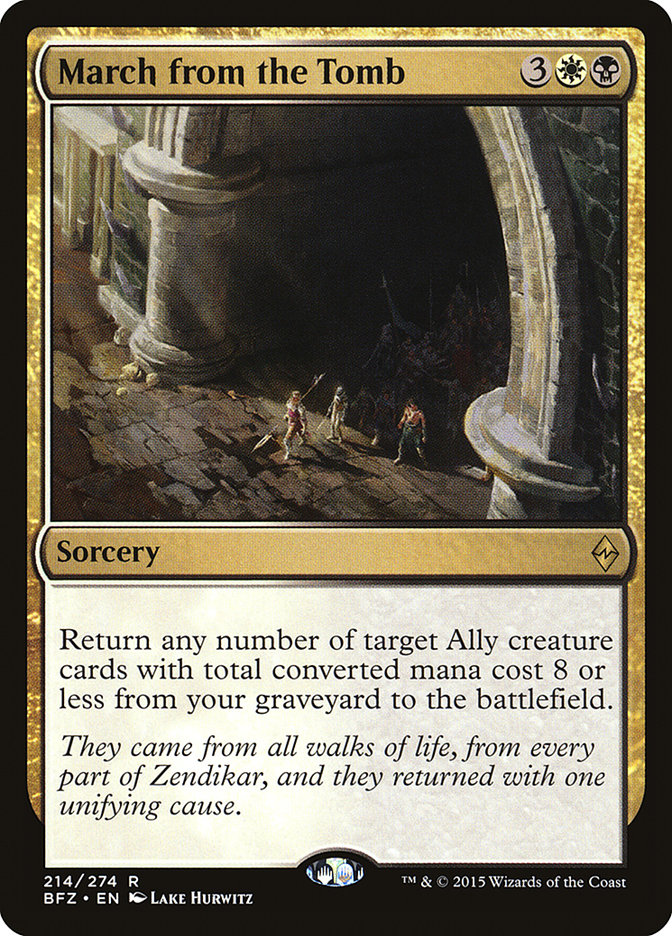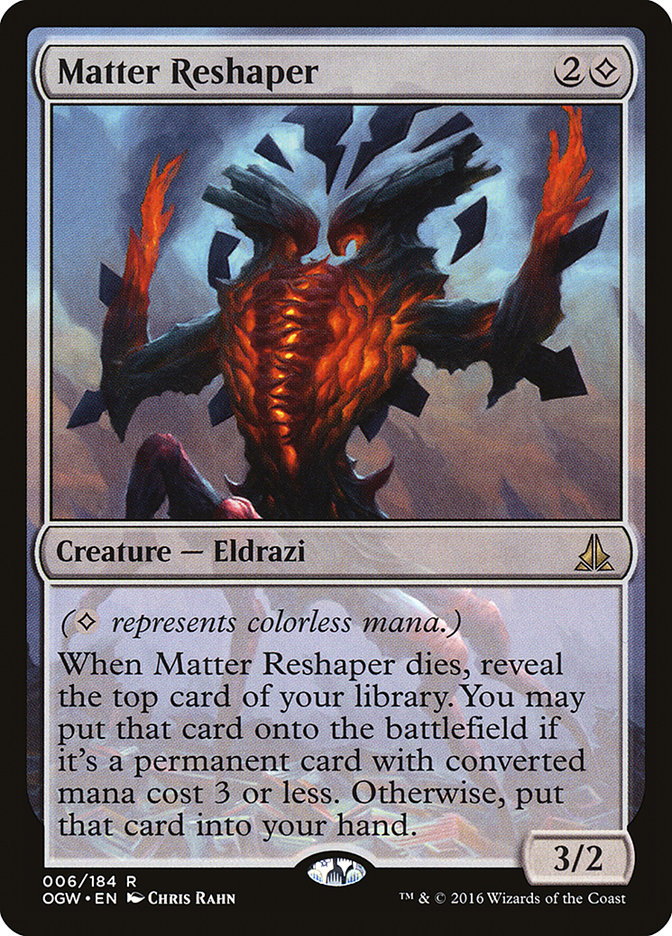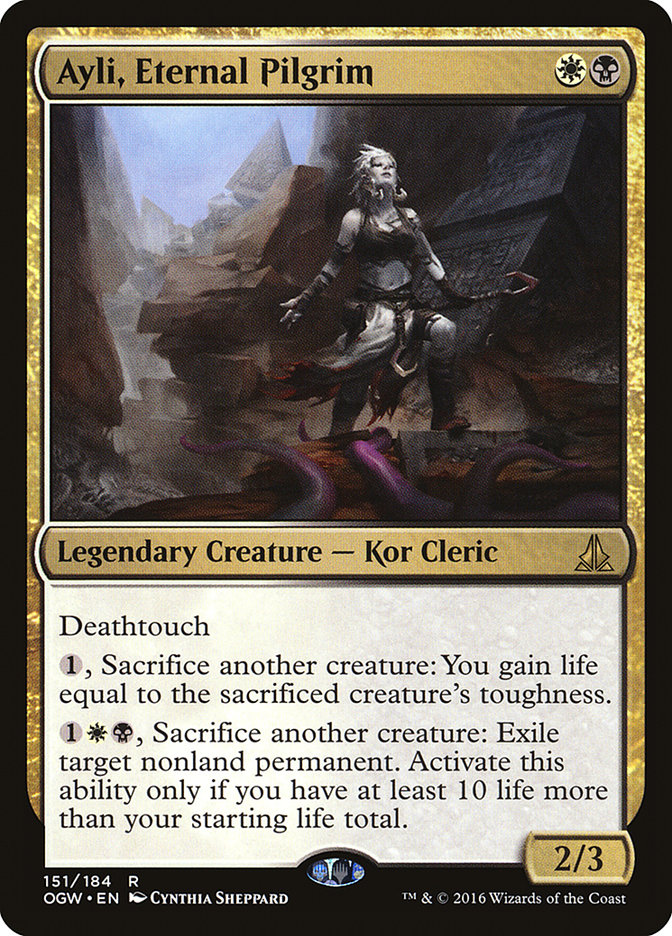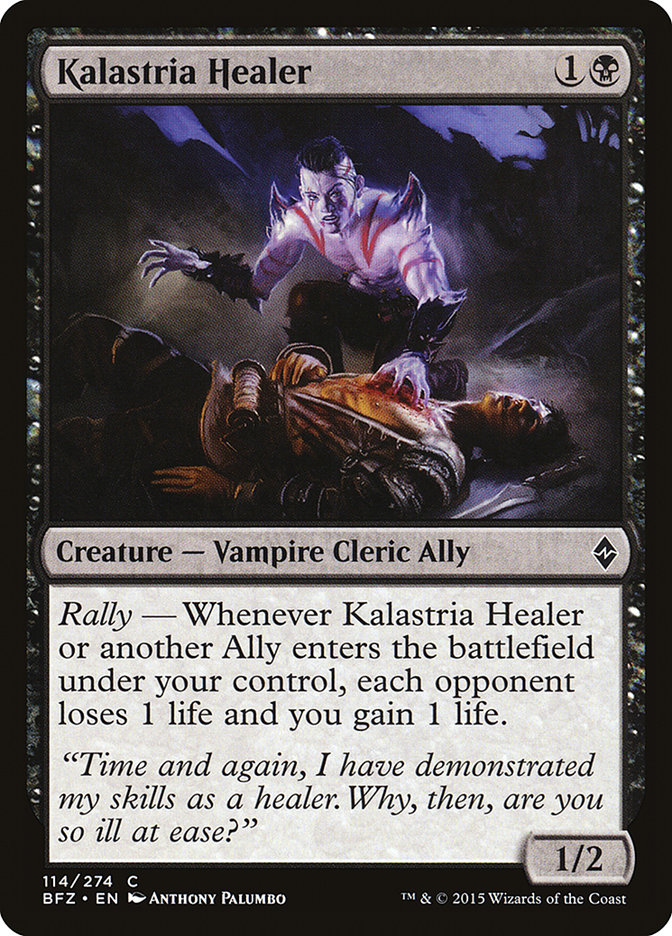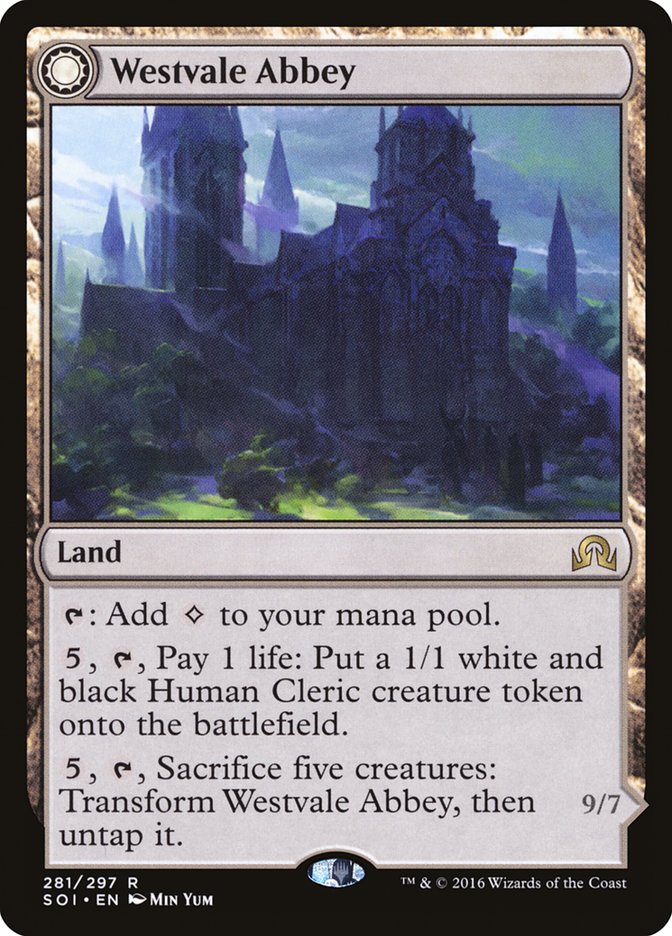Sorting cards is an odious task. It may also be never-ending, as I have no evidence to the contrary. There are always piles and piles of unsorted cards lying around the apartment for various reasons, and in fact I probably should spend some time sorting them this evening.
You cannot imagine my joy at that prospect.
It’s not all bad, though. Sometimes we find cards when sorting that spark something in the mind, that remind you of a half-formed idea from when you last saw that card. Perhaps something has been printed since that makes the idea now viable. Perhaps the metagame has evolved to a point where the card is now good. After all, that’s how people like Brad Nelson break formats.
For me, March from the Tomb has provided that spark on multiple occasions. Eight mana worth of creatures for a mere five mana? That’s a bargain! Sure, it has a restriction, but so does Collected Company and I believe that has seen some play.
Up until rotation, Rally the Ancestors was just a better card for Standard. As a result I had not been thinking about March from the Tomb at all and had basically forgotten it was even a card. That would change in a hurry at #GPToronto as I was getting my judge on around the top tables. One of the things I like to do when judging on the floor is to find interesting decks that are doing reasonably well and use them as starting points for brews. In Round 14, sitting at Table 17 and playing noted GP crusher Fabrizio Anteri, was Thiago Silva.
Thiago is not necessarily a household name, but in his local area of Toronto he is known as a brewer. Here he was, in contention for a money finish at his hometown Grand Prix, facing one of the five best players in the world piloting one of the best decks in the format in Bant Company…and he is pushing that player to the limit. Having won Game 1 at three life, Fabrizio looked at his opponent and said with genuine appreciation, “I really like your deck.” I don’t know how Thiago felt, but I would have sprouted wings and ascended to the ninth cloud.
Sadly, Thiago did not win the match. He missed an onboard kill in Game 3 that could well have seen him make Top 16. He would end up at 10-5, good for Top 150 (which is sadly not a thing), but for a brief moment he was within striking distance. And he was playing…Abzan Allies.
Creatures (25)
- 3 Veteran Warleader
- 2 Lantern Scout
- 3 Drana's Emissary
- 3 Drana, Liberator of Malakir
- 4 Kalastria Healer
- 4 Zulaport Cutthroat
- 4 Sylvan Advocate
- 2 Matter Reshaper
Lands (25)
Spells (10)

Oh, I’m not going to argue with you. This deck looks pretty off. Veteran Warleader? What does that card even do? Maindeck Lantern Scouts? What is going on with that manabase? Why is Drana’s Emissary in a 60-card deck? Had I seen the decklist before seeing the deck in action, I would have asked the same questions. But it works.
As the deck was constructed, I had a couple of concerns. Drana’s Emissary seemed a bit strange except for the flying, since we weren’t really doing anything with the lifegain. I was concerned that 25 lands would be too many in a deck that basically tops out at five, even if Westvale Abbey is essentially a spell. Abbey itself seemed out-of-place in a three-color deck, and the manabase in general was a bit of a concern. Matter Reshaper also was a bit jarring as the only non-Ally in the list, but with the ability to draw cards or just become another permanent, it made some sort of sense.
A few practice games confirmed my initial fears about the manabase. Although Westvale Abbey was not a problem, I did feel like one too many lands entered the battlefield tapped and we had one too many painlands. Veteran Warleader was amazing, especially in tandem with Sylvan Advocate. Zulaport Cutthroat was good and made cards like Languish a lot worse, but we all knew that going in. The real surprise, though, despite having seen the card in action in Toronto, was Kalastria Healer.
Draining the opponent for one whenever an Ally enters the battlefield seems like a minor upside. Then you remember that we are playing 23 Allies, and you think maybe we might be onto something. Then you realize that, at some point, we are going to have more than one on the battlefield. And then finally you imagine what happens when we do have two, and we hit two Allies on a Collected Company.
Life is very, very hard sometimes.
Ally Your Base Are Belong to Us
As FNM approached, I had some changes in mind. This is what I took with me:
Creatures (25)
- 3 Veteran Warleader
- 2 Lantern Scout
- 2 Drana's Emissary
- 3 Drana, Liberator of Malakir
- 1 Kor Bladewhirl
- 4 Kalastria Healer
- 4 Zulaport Cutthroat
- 2 Ayli, Eternal Pilgrim
- 4 Sylvan Advocate
Planeswalkers (1)
Lands (24)
Spells (10)

Kor Bladewhirl was a card I was sure would have an impact. If we’re going to play Allies, we might as well make the most of it with some rally triggers, and given that all the power/toughness buffs are out of Collected Company range, we’re not going to get much better than first strike. I did consider Makindi Patrol here, but ultimately the lower converted mana cost won out.
Ayli may not be an Ally [which makes literally no sense unless it was explained in the story (Copy Editor’s Note: it was)], but she looked like she would work really well in this sort of deck. We can use her to set up a large March from the Tomb, to trigger Zulaport Cutthroat, or to protect against Declaration in Stone. With the large amount of life we can gain, she is also likely to go Super Saiyan and start Vindicating to our heart’s content. Deathtouch is of course a nice plus to have on top of that package. Is she better here than the Matter Reshaper? My suspicion is yes.
One issue I saw with the deck was that it could run out of gas. Although I generally try to keep to ten or fewer cards that are a miss on Collected Company, Gideon provides too much value to pass up. Free triggers on Kalastria Healer, the ability to take our team out of Radiant Flames range, and of course the ability to beat down himself all make me very interested in what Gideon can give us.
The Bladewhirl and Gideon replaced the 25th land and a Drana’s Emissary, respectively. I also tinkered with the land mix a touch, though I left Westvale Abbey in the deck. The explosive potential of that card is large, and a singleton didn’t seem like a big ask.
I ended up having a mediocre record, beating G/R Goggles Ramp and W/B Midrange and losing to G/B Rite and G/W Tokens. The Rite deck killed me both games on his last turn before dying. The Tokens matchup was not good. I really felt the lack of a third Anguished Unmaking here, and if I recall correctly, I had some land issues in Game 3. The Ramp matchup was won by drawing three Kalastria Healer, having them all die to a Kozilek’s Return, and then bringing them all back with a March from the Tomb. That was a good feeling. All in all, though, I did find myself wishing I had another Ally to cast sometimes, and the Anguished Unmakings in particular felt out of place in the maindeck.
Ayli, Eternal Pilgrim did perform well and was overall worth the inclusion. I never got to use the Vindicate ability, mainly because I was never over 30 life when I had Ayli on the battlefield, but the sacrifice ability was excellent. The Bladewhirl was strong when I had it…which was exactly once. Gideon was surprisingly mediocre, though, and in fact might not be the game-winning super bomb he has been until now.
Marching Forward
I do think this shell is onto something, although it may be better kept at the store-event level. The potential for some powerful plays is definitely there, plus you get to make your opponent read cards. Here’s what I would play going forward:
Creatures (27)
- 3 Veteran Warleader
- 1 Tajuru Warcaller
- 2 Drana's Emissary
- 3 Drana, Liberator of Malakir
- 2 Kor Bladewhirl
- 2 Serene Steward
- 4 Kalastria Healer
- 4 Zulaport Cutthroat
- 2 Ayli, Eternal Pilgrim
- 4 Sylvan Advocate
Lands (24)
Spells (9)

Gideon, Ally of Zendikar had to go, at least to the sideboard. We want to be more controlling for the sideboarded games sometimes, and the Gideons play well with that. In his place I added a Tajuru Warcaller. The deck really needed something to push damage through, and the +2/+2 buff can make all the difference. Casting March with the Warcaller on the battlefield and any sort of presence will likely make a huge mess. We don’t have much in the way of trample (Veteran Warleader is it, basically), but we will make do with what we have.
I found myself stuck with multiple Marches in hand too often, so I shaved one. I also cut the Lantern Scouts, putting one in the sideboard. Although they lead to some large lifegain swings, the body is just not worth it. Instead I wanted to try Serene Steward. It’s slightly smaller but it does allow us to make use of all those Kalastria Healer, Zulaport Cutthroat, and Drana’s Emissary triggers while putting creatures out of Languish range.
The final change is cutting Westvale Abbey. There’s no doubt the card is powerful, but the greed of playing it in a three-color deck is felt all too often when you already have four lands (Ally Encampment) that cannot cast Collected Company. The damage from painlands was not an issue, so I am fine with adding the fourth Llanowar Wastes back in.
The increase in two-drops also makes March from the Tomb better. Too often I was only able to return two creatures with March, and the move to lower the curve does not do much to hurt our power level for creatures. With more rally triggers as well, we are even more likely to care about putting multiple creatures onto the battlefield in a turn.
One thing to watch is Drana, Liberator of Malakir. The card is no doubt powerful in a vacuum, but as we all know, the game is not played in a vacuum. If she does connect, she will win you games, but she most often just connects with a removal spell. That said, she is too potentially good not to play. You also want to be careful of decks with a lot of exiling removal, like Declaration in Stone and Stasis Snare. Against these decks you want to both diversify your threats on the battlefield and probably cut your March from the Tomb for sideboarded games. Ayli does help here, but it’s still rough.
I really enjoyed playing with this list. It has some potential to be good, though I really wish we had a good way to draw some cards. Both Duskwatch Recruiter and Matter Reshaper are possible, but they would likely have to replace Ayli. I don’t know that the trade-off there is worth it. Let me know what you think!
As always, folks, thanks for stopping by. I feel like I owe you an apology for the two mistakes I made in last week’s article. The Languish mistake was just a brain blip, but the mix-up with casting Eidolon of Countless Battles at instant speed when you have Rattlechains on the battlefield was due to me not realizing how a fairly recent rules change would interact with this. Before the change it worked fine, but now a spell’s legality is checked both on announcement and just after announcement. Without getting too technical, the spell would not pass the second legality check and would go back to our hand. This was my bad and I feel bad for missing it.
Thanks for setting me right, and as always…
Brew On!


